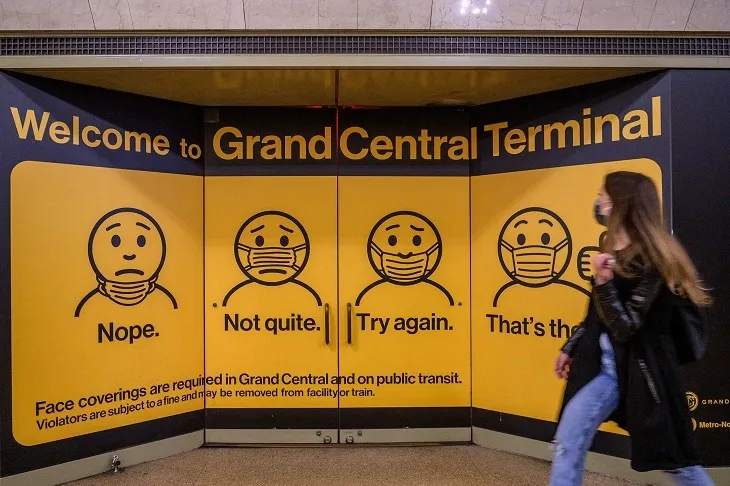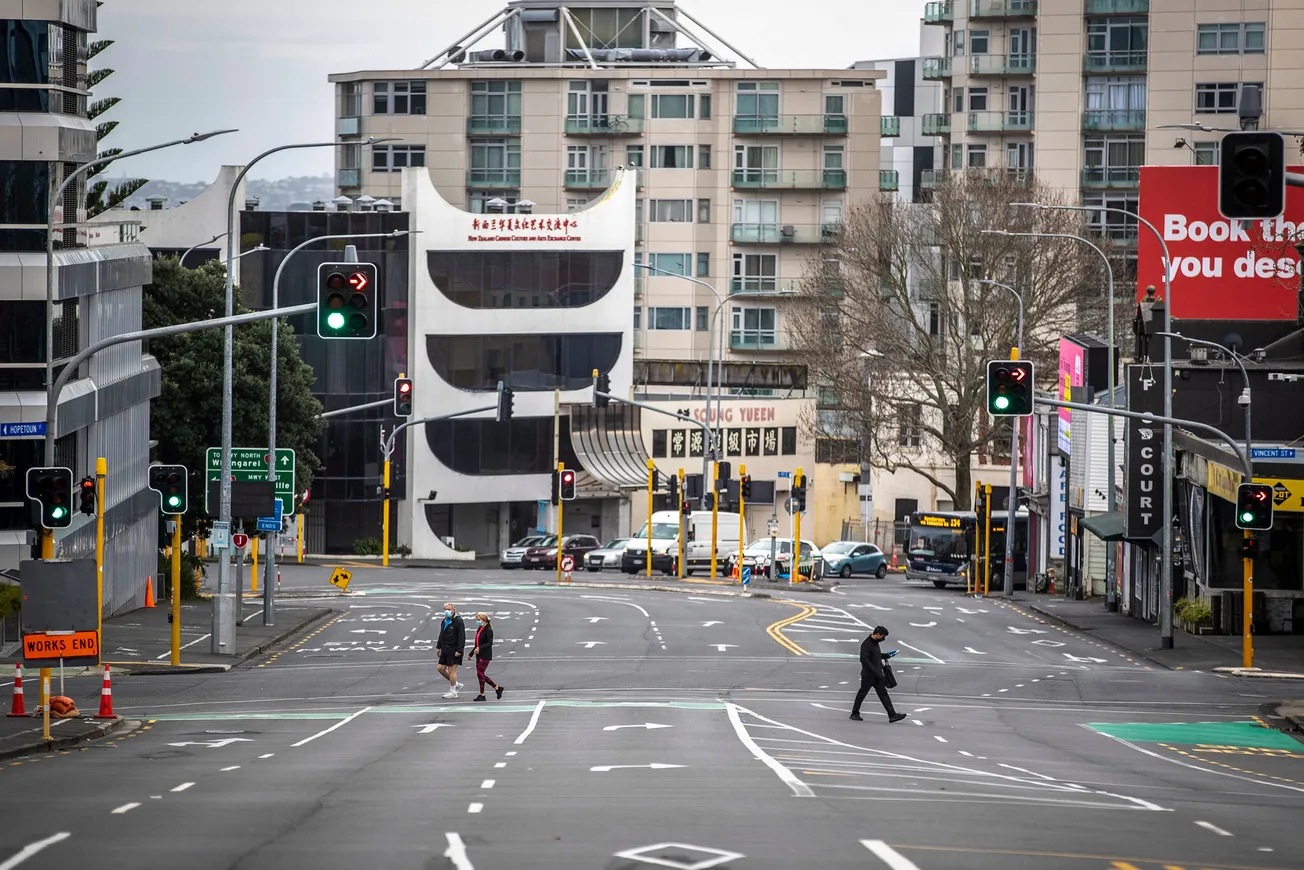AI
Like the previous post on how community mask mandates started in 2020, this was originally published in March 2023. But after re-reading Paul Thacker’s investigation into CDC mask flip-flops – and detailing how the Commission of Inquiry has an architect of the Covid response as Commissioner – I’ve taken more time here than I did previously to draw out some of the information within documents. I now doubt anyone ever reads what is referenced source material – including in this case Ministry of Health officials.
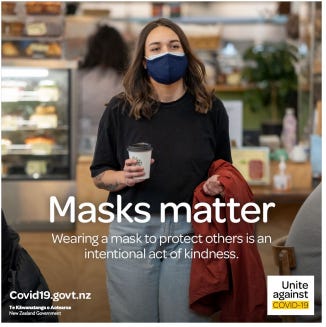
In August 2021 a Covid case in the community threw the entire country into a Level 4 lockdown, and by the following day Cabinet had issued further mask mandates extending beyond the existing public transport mandate to almost all indoor spaces that could be open (such as supermarkets).
It happened so fast as Cabinet had only just agreed days beforehand to enact further mask mandates across lower Alert Levels and to enforce mandatory contact tracing requirements too. The Cabinet paper on those changes from then Covid-19 Response Minster Chris Hipkins admits it was difficult to judge the overall risk reduction of doing so – but it was done on the assumption that higher Alert Levels would be less likely to happen.
Fines for not wearing a mask
Failure to comply with pandemic restrictions came with a cost and when the mask mandates were strengthened, infringements were also raised.
For individuals the penalty rose from $300 to $4,000. This could max out at $12,000 as a court imposed fine. A November 2021 briefing to Hipkins shows how infringements were used.
During just the Alert Level 4 lockdown in August 2021 Police issued 328 infringement notices, including 15 for not wearing a mask. Media articles start to show people were arrested, were refused service and outright fired from their jobs for not wearing a mask.
Lawyer Nathan Batts remarked on the difference in a speeding infringement ($630) versus the $4,000 for breaching a Covid restriction. Batts pointed out masks initially weren’t recommended – then became mandated with a considerable price for failure to comply.
Mask efficacy
As the mask mandates grew so to did Official Information Act (OIA) requests to the Ministry of Health. Some OIAs gave more than just generic responses noting WHO advice on masks – instead referencing an Irish rapid review, a Norwegian rapid review and a CDC scientific brief (now withdrawn) to prove masks work.
No OIA seems to have mentioned the Ministry of Health’s own inconclusive and cautious 2020 mask review yet these overseas reviews are also nuanced and uncertain. (Much like the June 2020 WHO advice that was aimed at places with sustained transmission – not Covid zero – which was claimed to be the reason for the start of the mask u-turn in 2020).
The Norwegian review baldly says “[masks are] widely perceived to be an effective means of reducing transmission and making it possible to engage in activities where social distancing is not possible. This perception has contributed to a political imperative to encourage or mandate the use of facemasks in the community, despite the lack of robust evidence”.
The expert panel consensus that Norway convened wasn’t exactly overwhelmingly in favour either:

In New Zealand, the mandate was for a face covering – which could be a bandana or a scarf – these reviews were focused on medical masks.
An OIA to the Department of the Prime Minister and Cabinet (DPMC) asked for a cost benefit analysis (CBA) on mask mandates. It was refused on the grounds it didn’t exist.
More community mask mandates
In late 2021 the lockdown-era Alert Levels were abandoned in favour of a politically driven traffic light framework of red/orange/green copied from Israel, and as the country slowly, slowly opened up again mask mandates became stricter and cases exploded.
A press conference in late January 2022 announced further indoor mask mandates – which included school children under 12 for the first time, as well as removing the use of face coverings. No longer was a bandana or a scarf seen as meeting the requirement, it had to be a mask. Then Prime Minister Jacinda Ardern stated “These adjustments will slow the spread of the virus”.
A little over a month after Ardern said that showed some of the highest transmission rates in the world belonged to New Zealand – on 1 day alone in March 23,000 cases were officially reported.
While transmission rose, on-going vaccination mandates led to protests at Parliament and in April 2022 the traffic light setting of red was dropped to orange. Orange saw domestic vaccine passes dropped, capacity limits in venues and hospitality relaxed, and masks were no longer mandated in schools (they were still encouraged and required on public transport to school).
But the community mask mandates stayed.
In mid-June a briefing to Cabinet and an accompanying memo from the Ministry of Health managed to make the un-referenced claim that face mask use reduces transmission by 50 to 75%. Yet in literally the following paragraph they note despite on-going pandemic restrictions – New Zealand faces “higher than expected rates of transmission”. This was clearly a deep cause for concern – as in July 2022 a review of restrictions at the red and orange setting of the traffic light framework took place and was sent to the new Covid-19 Response Minister Ayesha Verrall.
With rising hospitalisations, the Ministry of Health recommended no changes to mask mandates at either the red or orange setting be made, as it was not clear further mask use would affect transmission. Truthful statements appear concerning as it looks like Verrall sought further clarification (judging by the dated comments in the margins) that this advice was based on the feasibility of extended mandates not their actual effectiveness.
Despite that, in August 2022 Verrall breathlessly and somewhat bizarrely said in a press conference that the lowered traffic light setting of orange (that had been in place since April) was resulting in reported cases dropping! Ardern added to reporters “….it was clear masks were making a big difference…”
At the time Verrall and Ardern were making those statements there had been roughly 1.67 million reported cases in New Zealand. The vast majority had occurred after the expansion of the mask mandate in January and February 2022 as there had been only 20,000 cases up to that point due to the closed borders to maintain Covid zero.
In reality numbers were even higher. Estimates put it at probably more than double the officially reported case numbers.
Verrall was asked by a reporter why New Zealand was continuing with community masking when so many countries had dropped their use. She answered that New Zealand was different.
Randomised Controlled Trials (RCTs)
Media didn’t question Verrall on how New Zealand was different and I can only conclude she wouldn’t know herself as in the late 2020 Cabinet paper that led to the initial mask mandates on public transport, the Ministry of Health felt knowing if masks work via an RCT would “pose severe ethical issues”.
A criticism levelled overseas is too little high quality research such as RCTs were done in key areas such as community masking. The Ministry of Health does not conduct research but funds it. Neither government funded Covid nor infectious disease research appears curious as to whether community mask mandates reduced transmission.
Evaluation of mask mandates
Pandemic restrictions were reviewed at intervals. The previously mentioned June 2022 briefing to Cabinet also discussed upping behavioural nudging to maintain mask-wearing.
While no research appears on the actual effectiveness – huge amounts of research was done into New Zealander’s attitudes and behaviours during the pandemic. A Horizon survey commissioned by the Ministry of Health in June 2022 highlighted some comments on masks:
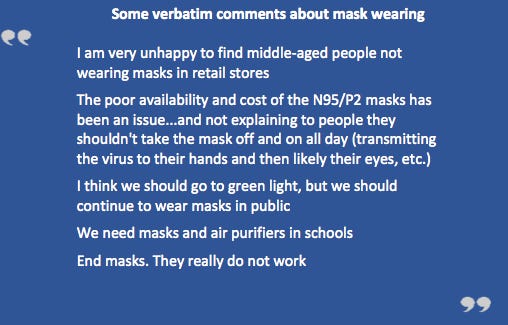
Overall the survey showed despite the mandate, people were no longer reporting they wore a mask most of the time. A July 2022 survey commissioned by DPMC had negative comments outstripping the positive and also confirmed people were not wearing masks as religiously as they previously said they did.
(The advertising campaign ‘masks matter’ from Clemenger BBDO was clearly behavioural nudging as compliance dropped.)
On the 11th of August 2022, the Ministry of Health provided their public health assessment on the value of mask mandates to Verrall. Officials referenced these various surveys:

And noted the community mask mandate was only useful if people supported it:

Officials wrote down their wish that mask-wearing would become a “default behaviour” by the public but they now felt recommending masks might have better results than a mandate:

There are references in multiple documents stating compliance was higher with a mandate – yet now they try to say the opposite is true!
Although the public health assessment called the evidence for masks “substantial” the justification for masks within the appendix references the infamous CDC-approved Georgia study that claimed teacher and student masking reduced rates of infection by a staggering 80 to 85% in schools.
This particular study had writer David Zweig write an August 2021 analysis and another again in The Atlantic in December 2021 calling into question those results due to the worryingly “shaky” modelling science it was based on, and the refusal of the researchers to provide the underlying data they used to get that result. (And besides, if that rate was true in August 2022 when the public health assessment was being written and sent to the Minister – wouldn’t Covid be better controlled?)
Further down the assessment officials attempt to answer the same question whether masks work – by using observational data to admit they can’t tell whether mask mandates within New Zealand schools had any impact on transmission rates.
Following the mask assessment, a further public health assessment across all restrictions was done on the 17th of August and on the 22nd of August a memo to inform an upcoming Cabinet paper was sent to the new Director-General of Health Diana Sarfati.
The memo recommended dismantling the traffic light framework – listing the reasons for doing so as: it was predicated not just on the Delta variant, but the assumption that vaccination would stop transmission and infection and even notes that red, the most restrictive setting within the framework, had “little impact” on transmission. The documents show all this was known months beforehand about the framework – but politically it was agreed to keep it in place over the New Zealand winter. Within the memo officials recommended mask mandates be kept on only public transport and in healthcare settings.
The eventual Cabinet paper brought to the Social Wellbeing Committee by Verrall had an accompanying Regulatory Impact Statement that says mask mandates were “effective” in protecting M?ori and Pacific people (there’s no reference to support the statement) and called for the Ministry of Health’s original recommendation to keep masks on public transport too.
Yet Verrall recommended “strong guidance” be provided to wear masks on public transport and elsewhere and the mandate for community masking was dropped. There’s no clear reference to why public transport was not included aside from a comment on mask fatigue.
Verrall requested a separate Order be created to continue the healthcare based mask mandate as it would be easier to amend if they wanted to reinstate community mask mandates in the future. By the time community mask mandates were outright dropped (except for in healthcare) on the 12th of September 2022 – there had been roughly 1.7 million reported cases.
Surveys on compliance as a substitute for data to fulfil decision making requirements
DPMC responded in an OIA “For the impact of mask mandates, it is reasonable to conclude that mask mandates were having a positive impact on the outbreak for the period they were in place”.
But following the trail of many, many OIAs finds through their own words – there is absolutely no known data within New Zealand for countless statements that masks at a community level were “making a difference” or that they had a “positive impact”.
Only self-reported compliance was tracked via online surveys – not actual effectiveness.
While community mask mandates were lifted in September except for healthcare, a mere 2 months later it was re-reviewed in preparation for summer. An early December 2022 Cabinet paper by Verrall kept mandatory isolation timeframes. The Regulatory Impact Statement again advocated for public transport mask mandates:

While elderly people were most at risk (the average age of death was 83 from Covid according to this August 2022 OIA) the isolation and mask impact on older people is a shaky conjecture that appears based on modelling data within the Cabinet paper.
It appears modelling data and the online surveys contributed towards fulfilling the required factors Cabinet needed to consider when making decisions, such as the evidence of the effects of pandemic restrictions on the economy and society, and public attitudes and the extent to which people accept following measures.
The Cochrane Review & mask guidance in the present day
A 2023 OIA requesting myocarditis research had the Ministry of Health respond that systematic reviews are useful:

All of the sources referenced in OIAs paled when compared to what the Ministry of Health itself says when they refer to Cochrane as being “…considered the gold standard for determining the relative effectiveness of different interventions”.
The Cochrane review of physical interventions including mask use has been updated several times, and when it was last updated in early 2023 it continued to find little evidence underpinning masking.
Investigative journalist Paul Thacker interviewed the lead author, Tom Jefferson. He makes what seems a sage point when his research found no benefit yet there was no change in advice “Well, government proposed these interventions, so they’re not going to police themselves. This is just like pharma.”
An OIA request on the review had the Ministry of Health respond that they note “…the findings of the Cochrane study and will continue to monitor emerging international evidence regarding COVID-19 including evidence of mask efficacy.”
The current mask recommendations (in May 2024) if you are not sick nor have Covid appear the same as at the height of community mask mandates:
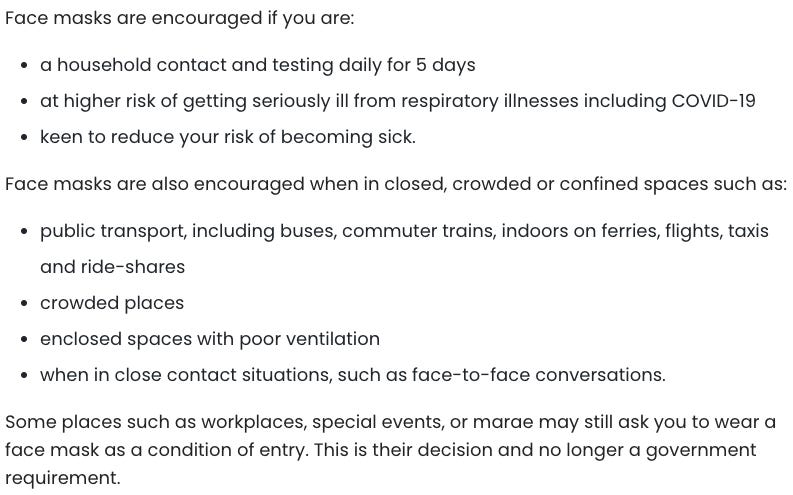
They also recommend masking if you have Covid too.

